People often think you need an entire gym to get in shape or target every part of your body, but using one piece of equipment per workout can also be effective. The barbell, for example, is a highly versatile and functional method for everything from increasing flexibility to body building.
With just nine exercises, this mini-circuit, full-body workout is super efficient, requiring only a barbell and a bit of space. Don’t forget to include a proper warm-up and cool-down, use a timer to keep you on track, and try to increase the intensity and/or number of reps with each round. The workout includes:
- 3 exercises for each circuit
- 4 rounds for each set, rotating R/L side each round
- 30 seconds on/10 seconds off
Note: Barbells come in a variety of sizes, so be sure to start with one that is appropriate for you.
SET #1 (requires a protected corner)
1. Upright High Pull
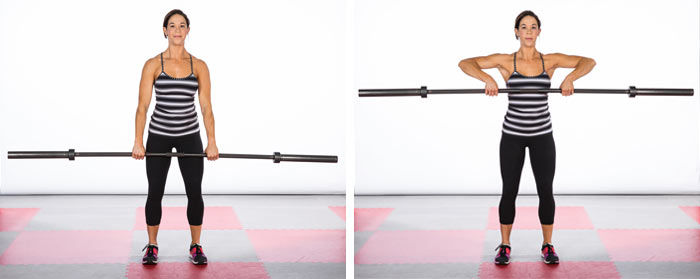
Begin in a tall, athletic stance with knees slightly bent, core engaged and shoulders back. Hold the barbell with hands positioned about 8 inches apart; lead the movement by drawing the elbows upward. Keep the wrists straight and chest open as you pull the barbell up toward your chin. Your elbows should end higher than your shoulders. Lower the weight with control by keeping your shoulders back and your core engaged. Keep your gaze straight ahead; do not drop your head. Keep the abdominals braced. Your feet should stay firmly planted on the ground as you move the weight up and down.
Muscles used: traps, rhomboids, lats, shoulders, biceps and core
2. Stationary Suitcase Lunges
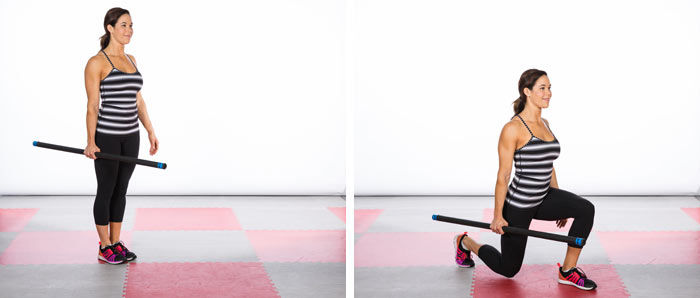
Start with your feet hip-width apart at the side of the barbell. Squat down to pick the barbell up with one hand, slightly off-centered so the barbell stays parallel to the ground. Stand up slowly, keeping your body centered and shoulders even. Once you have stood up, slowly step forward and find your balance on the standing leg. Try not to move the standing foot and maintain balance without wobbling. Hold this position briefly before stepping forward. Keep the barbell steady by engaging your core. The raised foot should land on the heel first. Slowly shift your body weight onto the lead foot, placing it firmly on the floor. As you shift your body weight to the lead foot/leg, avoid the tendency to tilt or sway the upper body and try not to move the forward foot. During the movement, slightly bend forward at your hips and keep the back straight. Firmly push off with the front leg, activating both your thighs and glutes to return to an upright, starting position.
Muscles used: glutes, quads, core, shoulders and calves
3. Hay Bailers

Place the end of a standard barbell in a corner so that it won’t move from side to side. Stand facing the end of the barbell so that it is between both feet and directly under your center of gravity. Your feet should be slightly farther than shoulder-width apart, with your toes pointed forward or slightly outward. Engage the abdominals and pick up the free end of the barbell. Hold the end of the bar with both hands to the right of your body; keep your fingers interlaced so that you have a tight grip. Throughout the exercise keep your feet planted in the ground, push your hips forward and engage your abdominals (bracing) to maintain spinal stability. Shift your weight to your right leg while rotating the barbell upward at a 45-degree angle. Lower the barbell back to your right side by pushing with the left arm and pulling with the right arm. Allow your left shoulder to rotate toward your right side. Maintain a strong, tight grip with your feet firmly planted on the ground. Keep your gaze straight ahead. Repeat on the right side and switch to the left side after the first round.
Muscles used: abs, arms, back, chest and shoulders
SET #2 (requires a roman chair, stability ball or bench)
4. Back Extensions
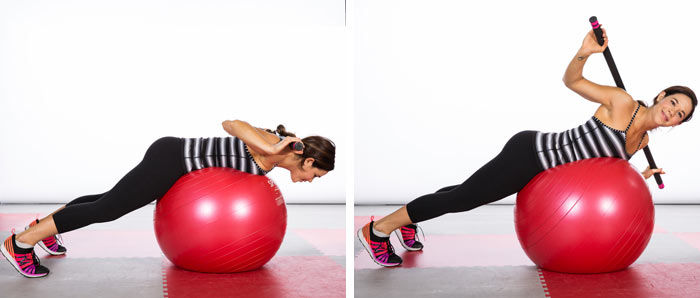
Start by setting the barbell or weight bar in front of a bench, stability or roman chair. Get comfortable so your thighs are placed evenly on the surface; fully extend your legs. You should be able to balance evenly without falling forward. Reach forward and grab the barbell so your elbows are at 90 degrees. Place the barbell behind your head on the padded parts of your scapulae, being careful to avoid the cervical spine. Engage your core and glutes and slowly pull yourself up so your body is one flat line without hyperextending your back. Slowly lower your upper body back down while keeping your neck aligned with your spine. If you feel comfortable enough to include a small twist, slowly begin a rotation to the right side once your body is in extension. Return to the starting position at flexion, extend upward and rotate slowly to the left side. Once the set is completed, slowly raise the bar off your back and lower it to the ground before dismounting.
Muscles used: lower back, obliques, glutes and hamstrings
5. Ab Rollouts

Begin by kneeling on a mat with the barbell placed in front of you. Crouch down into an all-fours position and grab the bar shoulder-width apart. Keep your head aligned naturally with your spine, engage your abdominals, squeeze your glutes and slowly let the bar drift away from your body. Let the barbell roll out evenly and feel the tension pulling through your core. Start with a small range of motion to get comfortable with the motion and slowly increase the difficulty by rolling out farther with each rep. Progress to where your arms and core are parallel with the ground.
Muscles used: abdominals, shoulders and chest
6. Skull Crushers
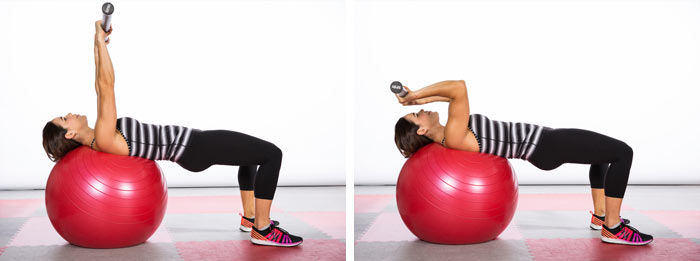
Start on a stable surface (or use a BOSU or stability ball if you would like an additional challenge). Begin by sitting upright with the barbell across your lap. Lie on your back on a flat bench with your feet firmly on the floor. Slowly press the barbell off your chest. Grasp the bar with an overhand grip with hands about shoulder-width apart. Slowly lean backward and raise the bar over your chest. Be sure to keep your elbows pointing upward as you lower your forearms and bring the bar close to your forehead by keeping your wrists straight. Breathe out and extend your arms back up toward the ceiling, but be careful not to lock your elbows. Repeat and keep the bar balanced throughout to help create stability and promote strength through the wrists and forearms.
Muscles used: triceps, shoulders and forearms
SET #3 (requires a shoulder pad or yoga mat)
7. Hip Thrusters

Lie on the ground or a bench with feet hip-width apart and place a barbell over your hips. Place your hands in a wide grip to prevent your arms from resting on the ground (use a pad if necessary). Gently contract your abdominal muscles to flatten your low back into the floor; try to maintain this gentle muscle contraction throughout the exercise. Begin the movement by squeezing the glutes and raising the hips toward the ceiling; try to create a flat line from the knees through the hips to the shoulders. Avoid pushing your hips too high, which can cause hyperextension (arching) in your low back. Hold the position for two seconds and then release to the floor. Repeat the movement, keeping the knees hip-distance apart to keep the glutes activated. To progress the exercise, add more weight or place your feet on a platform.
Muscles used: glutes, hamstrings and core
8. Leg Raise With Barbell Press
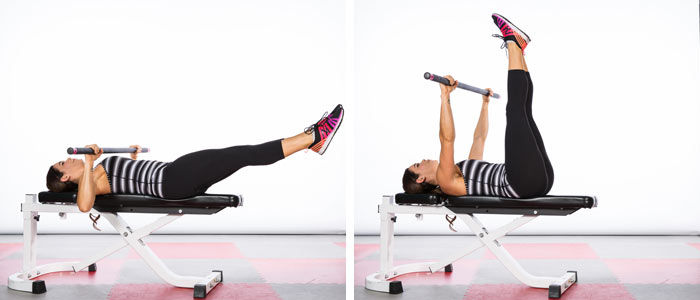
Begin by lying flat on a bench with your legs flat on the bench; place the barbell over your chest. Slowly raise your legs while contracting your abdominal muscles to flatten your lower back into the bench. Keep your wrists in a neutral position and your forearms vertical to the floor. Do not allow the back to arch away from the bench. Slowly press the bar up to meet your feet without bringing your shoulders or head off the bench. Exhale and slowly return your legs and arms to the starting position.
Muscles used: abdominals, chest, quads and shoulders
9. Forearm Curls
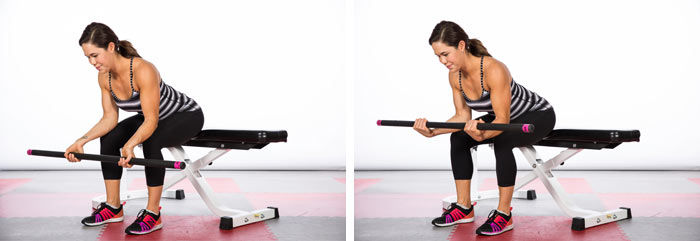
With this exercise, you can challenge your core by sitting on a stability ball, but if you want a steady base, sit on a bench or platform. Begin this exercise by using an underhand grip with hands about shoulder-width apart. Sit firmly, with your elbows resting on your knees, and keep a flat back with your chest open to support your core. Slowly flex your wrists upward and then lower toward the floor. If you are sitting on a stability ball, bring your legs closer together to create a greater challenge for your core.
Muscles used: core, forearms, and shoulders




 by
by 








